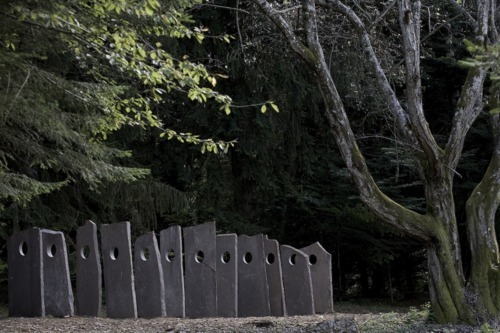
Steven Siegel, Bridge II, 2009
Milan. At the crack of dawn. The city is emptying, but not like other years. It’s less hard to stay. We’ve this weird habit in Italy, time seems to stop for a month. Most of people takes their holidays in August, including politicians, business and finance people, even if Italy is collapsing.
It’s time for Dead Curious to make a trip. Let’s go to Val di Sella, in the municipality of Borgo Valsugana, in the province of Trento, in the “well-known” industrial northeast of Italy.
You can cosily park your car in a patch. On a wood stand a well-drawn map indicates time and miles to go. Better to have hiking boots, the ground is covered by a layer of wet leaves. You enter the wood and slowly get acquainted with the place and find it out. The heartbeat rises and conversation stops. It’s just a matter of training, because the climb is not steep, quite the opposite.

François Lelong, Les Pierres, 2008
Occasionally you were broken by what we can call “epiphanies”. At first unrecognizable because they are made with the same materials of nature, sculptures and installations appear, such as the spiral of American artist Roy F. Staab that takes possession of the space between trees. Hereinafter you are hypnotized by the presence of two wolves made of a mixture of lime and leaves. It’s an English artist, Sally Matthews. What a fright, in spite of the fiction, the same you have felt when you was a child. Childhood resurfaces, really, smelling grass and resin. Sometimes it’s easy to go back in time if you’re in the right place and with the right people. Be satisfied of viewing the variety of green, the light that pierces the foliage and creates a surface of spots as in a Renoir’s painting is a luxury. You can feel your body and time, the nature one.
Arte Sella was born in 1986. The artworks are all made of natural materials, the ones you can find there. They could not exist elsewhere. Some of them have already disappear, only photographic documentation remains.
Beyond the wood, a valley opens full of centuries-old trees fed by the generous rain. You enter a field where a old barn has been transformed in a temporary exhibitions venue.
You feel like an elf – oh my god, my ears are pointed! – among Armin Schubert’s Dancers, whose wooden tutù are whirling and Julian Orsingher’s Nests of Water that stay in balance between the branches and are made of stones, to accomodate the rain water and some insects that have dippen in. Some gardeners are cutting the grass floor of Giuliano Mauri’s Vegetal Cathedral, lightly going around the mighty pillars that branch out towards the sky.
You can interact with François Lelong optical installation made of stones, with the bridge of newspaper by Steven Siegel that time has hardened like cement. You can find out the mistery of photography in the Chris Drury’s “dark room”.

Chris Drury, Sky Mountain Chamber, 2010
While you are dancing among installations like a butterfly, you could think about Joseph Beuys’s 7000 oaks planted in Kassel, or land artists who had left the studio work and constructed a new alphabet and a new language in nature, in the vacuum of deserts, in degraded urban areas, in abandoned quarries, in rivers and lakes. They had come out of the isolation of galleries and museums to act within the manufacturing process, developing a non-traumatic relationship with the environment, a relationship of dialogue and integration, claiming the social role of art as a synthesis between the “green” requests and the potentialities of industry, anticipating, in some way, the most pressing issues that today we need to resolve.
Mario Merz used dry branches too to build his Igloo but perhaps we don’t need art history to understand Arte Sella. Here you can have an uncommon and advanced museological experience with the same cheerful and shabby (but active) participation of playtime after school.
Courtesy Arte Sella.
Photos: Giacomo Bianchi.
